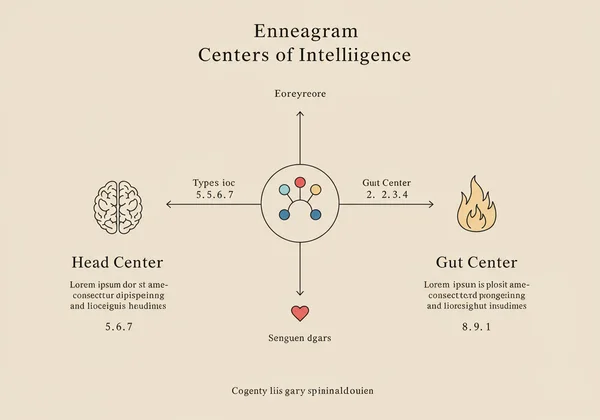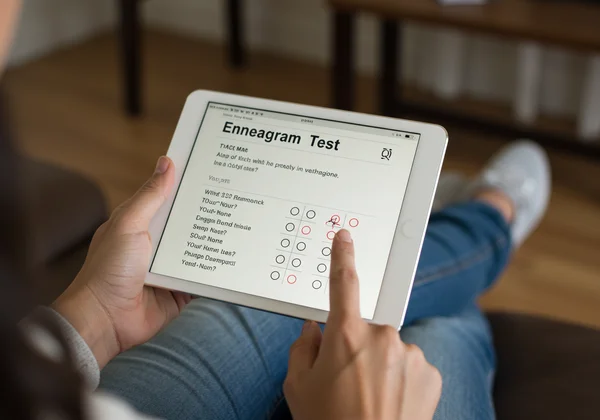Enneagram ในมิติที่ลึกกว่า: ค้นพบต้นแบบ Tritype ของคุณ
คุณเคยทำ แบบทดสอบ Enneagram และพบประเภทของคุณแล้ว แต่ยังรู้สึกว่ามีบางอย่างขาดหายไปหรือไม่? คุณรู้สึกเชื่อมโยงกับประเภทหลักของคุณ แต่ก็เห็นองค์ประกอบที่แข็งแกร่งของตัวเลขอื่นๆ ในบุคลิกภาพของคุณด้วย แต่จะเกิดอะไรขึ้นถ้าบุคลิกภาพของคุณยังมีอีกมิติที่รอให้คุณค้นพบ? นี่คือแนวคิดที่น่าสนใจของ Enneagram Tritype ซึ่งนำเสนอ มุมมอง ที่สมบูรณ์และมีมิติมากขึ้นเกี่ยวกับตัวคุณ การเดินทางเพื่อทำความเข้าใจชั้นที่ลึกซึ้งยิ่งขึ้นนี้เริ่มต้นด้วยก้าวเดียว และคุณสามารถ เริ่มต้นการค้นพบตนเอง ได้ตั้งแต่วันนี้
ในฐานะผู้ที่ชื่นชอบจิตวิทยา ฉันได้เห็นว่ากรอบแนวคิดบุคลิกภาพสามารถเป็นเครื่องมือที่ยอดเยี่ยมสำหรับการเติบโตได้อย่างไร Enneagram นั้นทรงพลัง แต่ทฤษฎี Tritype ยกระดับไปอีกขั้นหนึ่ง มันชี้ให้เห็นว่าเราไม่ได้ทำงานจากประเภทหลักเพียงประเภทเดียว แต่จากประเภทที่ต้องการในแต่ละศูนย์แห่งปัญญา (Centers of Intelligence) ทั้งสาม ซึ่งสร้าง "ต้นแบบ" ที่เป็นเอกลักษณ์ซึ่งเผยให้เห็นแนวทางที่ละเอียดอ่อนของคุณในการใช้ชีวิต
Enneagram Tritype คืออะไร?
ทฤษฎี Enneagram Tritype® ซึ่งพัฒนาโดย Katherine Chernick Fauvre เสนอว่าเรามีประเภท Enneagram ที่โดดเด่นในแต่ละศูนย์แห่งปัญญา (Centers of Intelligence) ทั้งสาม ได้แก่ กลุ่มหัว (Head), กลุ่มใจ (Heart) และกลุ่มท้อง (Gut) Tritype ของคุณคือการรวมกันของประเภททั้งสามนี้ โดยเรียงลำดับตามความชอบ โดยมีประเภทหลักของคุณเป็นอันดับแรก ตัวอย่างเช่น หากประเภทหลักของคุณคือ 4 ประเภทหัวของคุณคือ 7 และประเภทท้องของคุณคือ 8 Tritype ของคุณจะเป็น 478
นี่ไม่ใช่การมีบุคลิกภาพที่แตกต่างกันสามแบบ แต่เป็นการทำความเข้าใจลักษณะเฉพาะที่บุคลิกภาพของคุณแสดงออกมา ประเภทหลักของคุณยังคงเป็นแรงขับเคลื่อนหลักของคุณ — เลนส์หลักของคุณในการมองโลก อย่างไรก็ตาม ประเภทอีกสองประเภทใน Tritype ของคุณเป็นตัวแทนของกลยุทธ์ที่คุณใช้เป็นค่าเริ่มต้นเมื่อกลยุทธ์หลักของคุณไม่ได้ผล สิ่งนี้สร้างโปรไฟล์ แบบทดสอบบุคลิกภาพ Enneagram ที่มีพลวัตและแม่นยำยิ่งขึ้น มันอธิบายได้ว่าทำไม Type 9 อาจมีด้านที่เฉียบคมและวิเคราะห์ (จาก 5 fix) หรือทำไม Type 2 อาจมีแรงผลักดันที่ทะเยอทะยานอย่างแรงกล้า (จาก 3 fix)

ศูนย์แห่งปัญญาทั้งสามกำหนด Tritype ของคุณได้อย่างไร
ในการทำความเข้าใจ Tritype ของคุณ ก่อนอื่นคุณต้องเข้าใจศูนย์แห่งปัญญาทั้งสาม แต่ละศูนย์ถูกควบคุมโดยอารมณ์หลักและกำหนดว่าเราประมวลผลข้อมูลและตอบสนองต่อโลกอย่างไร ทุกคนมีประเภทที่ต้องการภายในแต่ละศูนย์เหล่านี้ ซึ่งรวมกันเป็น Tritype ที่เป็นเอกลักษณ์ของคุณ การทำ แบบทดสอบ Enneagram ที่แม่นยำ เป็นวิธีที่ดีที่สุดในการเริ่มต้นระบุศูนย์และประเภทที่โดดเด่นของคุณ
กลุ่มหัว (ประเภท 5, 6, 7)
กลุ่มหัว หรือศูนย์ความคิด ถูกขับเคลื่อนด้วยอารมณ์ความกลัว มันเกี่ยวข้องกับความมั่นคง การจัดการความวิตกกังวล และการวิเคราะห์โลกเพื่อสร้างความแน่นอน ผู้ที่นำด้วยศูนย์นี้จะเป็นคนที่มีวิสัยทัศน์ วางแผนเชิงกลยุทธ์ และมุ่งเน้นการสร้างแผนและการรวบรวมข้อมูลเพื่อให้รู้สึกปลอดภัยและพร้อม
- ประเภท 5 (นักสืบ): จัดการความกลัวด้วยการถอนตัวเพื่อวิเคราะห์และรวบรวมความรู้
- ประเภท 6 (ผู้ภักดี): จัดการความกลัวด้วยการแสวงหาการสนับสนุน ตั้งคำถามกับอำนาจ และเตรียมพร้อมสำหรับสถานการณ์ที่เลวร้ายที่สุด
- ประเภท 7 (ผู้กระตือรือร้น): จัดการความกลัวด้วยการหลีกเลี่ยงความเจ็บปวดและแสวงหาประสบการณ์ที่กระตุ้นและเป็นบวก
กลุ่มใจ (ประเภท 2, 3, 4)
กลุ่มใจ หรือศูนย์ความรู้สึก ถูกขับเคลื่อนด้วยอารมณ์ความละอาย มันเกี่ยวข้องกับภาพลักษณ์ ความสัมพันธ์ และความต้องการที่จะถูกมองเห็นและได้รับการให้คุณค่าจากผู้อื่น ผู้ที่นำด้วยศูนย์นี้จะมีความเข้าใจผู้อื่นเป็นอย่างดี มุ่งเน้นไปที่อัตลักษณ์ของตนเอง และแสวงหาการยอมรับและการเชื่อมโยงเพื่อยืนยันคุณค่าในตนเอง การทำความเข้าใจศูนย์นี้เป็นกุญแจสำคัญสำหรับ แบบทดสอบ Enneagram สำหรับความสัมพันธ์
- ประเภท 2 (ผู้ช่วยเหลือ): จัดการความละอายด้วยการมุ่งเน้นความต้องการของผู้อื่นเพื่อให้รู้สึกเป็นที่รักและขาดไม่ได้
- ประเภท 3 (ผู้ประสบความสำเร็จ): จัดการความละอายด้วยการสร้างภาพลักษณ์ที่ประสบความสำเร็จเพื่อได้รับการยอมรับและชื่นชม
- ประเภท 4 (ปัจเจกชน): จัดการความละอายด้วยการสร้างเอกลักษณ์เฉพาะตัวเพื่อให้รู้สึกเป็นของแท้และเป็นที่เข้าใจ
กลุ่มท้อง (ประเภท 8, 9, 1)
กลุ่มท้อง หรือศูนย์สัญชาตญาณ ถูกขับเคลื่อนด้วยอารมณ์ความโกรธ มันเกี่ยวข้องกับการควบคุม ความยุติธรรม และการยืนยันตำแหน่งของตนเองในโลก ผู้ที่นำด้วยศูนย์นี้จะมีความรู้สึกถึงสัญชาตญาณและการรับรู้ที่แข็งแกร่ง โดยมุ่งเน้นการรักษากฎเกณฑ์และการควบคุมสภาพแวดล้อมเพื่อต่อต้านการถูกควบคุมโดยผู้อื่น
- ประเภท 8 (ผู้ท้าทาย): จัดการความโกรธด้วยการแสดงออกโดยตรงเพื่อปกป้องตนเองและควบคุมชีวิตของตนเอง
- ประเภท 9 (ผู้สร้างสันติ): จัดการความโกรธด้วยการระงับมันเพื่อรักษาสันติภาพและความกลมกลืนภายในและภายนอก
- ประเภท 1 (นักปฏิรูป): จัดการความโกรธด้วยการเก็บกดมันและเปลี่ยนให้เป็นความวิพากษ์วิจารณ์ตนเองและแรงผลักดันสู่ความสมบูรณ์แบบ
ทำไม Tritype ของคุณจึงสำคัญต่อการเติบโตส่วนบุคคล
การรู้ Tritype ของคุณเปรียบเสมือนการได้รับ แผนที่ที่ละเอียดมาก ของโลกภายในของคุณ ในขณะที่ประเภทหลักของคุณคือประเทศที่คุณอาศัยอยู่ Tritype ของคุณเผยให้เห็นเมืองและ ลักษณะเฉพาะ ที่คุณไปเยือนบ่อยที่สุด ความเข้าใจนี้ให้ประโยชน์อย่างลึกซึ้งต่อ การเติบโตส่วนบุคคล มันช่วยให้คุณเห็นรูปแบบที่ซ่อนอยู่ในกระบวนการตัดสินใจของคุณ โดยเฉพาะอย่างยิ่งภายใต้ความเครียด

ตัวอย่างเช่น คุณอาจตระหนักว่าความขัดแย้งภายในของคุณแท้จริงแล้วคือการโต้แย้งระหว่างสามประเภทใน Tritype ของคุณ Tritype 9-2-5 อาจต่อสู้ระหว่างความปรารถนาของ 9 ในเรื่องสันติภาพ ความต้องการของ 2 ในการช่วยเหลือผู้อื่น และความต้องการของ 5 ในเรื่องเวลาส่วนตัวเพื่อชาร์จพลัง การตระหนักถึงพลวัตภายในนี้เป็นก้าวแรกสู่การค้นหาสมดุล ความรู้ที่ลึกซึ้งยิ่งขึ้นนี้ช่วยให้คุณก้าวข้ามคำอธิบายประเภทง่ายๆ และสร้างเส้นทางสู่การตระหนักรู้ในตนเองที่เป็นส่วนตัวอย่างแท้จริง พร้อมที่จะดูแผนที่แล้วหรือยัง? เริ่มต้นก้าวแรก
วิธีค้นหา Enneagram Tritype ของคุณ: คู่มือง่ายๆ
การค้นพบ Tritype ของคุณคือการเดินทางของการ สำรวจตนเองอย่างลึกซึ้ง แต่มันเริ่มต้นด้วยก้าวแรกที่ชัดเจนและสำคัญ: การระบุประเภท Enneagram หลักของคุณอย่างแม่นยำ นี่คือรากฐานที่ Tritype ทั้งหมดของคุณ ก่อตัวขึ้น
- ระบุประเภทหลักของคุณ: วิธีที่น่าเชื่อถือที่สุดในการเริ่มต้นคือการทำ แบบทดสอบ Enneagram ฟรี ที่ครอบคลุม แบบทดสอบของเราออกแบบมาเพื่อช่วยคุณระบุแรงจูงใจและความกลัวหลักที่กำหนดประเภทที่โดดเด่นของคุณ ซื่อสัตย์กับคำตอบของคุณและมุ่งเน้นไปที่แรงขับเคลื่อนที่ซ่อนอยู่ ไม่ใช่แค่พฤติกรรมของคุณ
- ระบุประเภทที่เสริมในแต่ละศูนย์: เมื่อคุณทราบประเภทหลักของคุณแล้ว คุณต้องระบุว่าคุณใช้ประเภทใดมากที่สุดในอีกสองศูนย์ ตัวอย่างเช่น หากประเภทหลักของคุณคือ 6 (กลุ่มหัว) คุณจะต้องสำรวจว่าคุณเชื่อมโยงกับประเภทใจ (2, 3 หรือ 4) และประเภทท้อง (8, 9 หรือ 1) ใดมากที่สุด
- สะท้อนและสังเกต: ขั้นตอนนี้ต้องใช้การไตร่ตรอง ลองคิดดูว่าคุณตอบสนองอย่างไรภายใต้ความกดดันเมื่อกลยุทธ์หลักของคุณล้มเหลว แผนสำรองที่คุณใช้คืออะไร? คำตอบมักจะชี้ไปที่ประเภทอีกสองประเภทใน Tritype ของคุณ

แม้ว่าการทดสอบแบบรวดเร็วจะไม่สามารถเปิดเผย Tritype ทั้งหมดของคุณได้อย่างแน่นอน แต่แพลตฟอร์มของเราก็มีจุดเริ่มต้นที่สำคัญ หลังจากที่คุณได้รับ แบบทดสอบ Enneagram ฟรีและผลลัพธ์ แล้ว คุณสามารถเลือกรายงานที่ขับเคลื่อนด้วย AI ที่เป็นเอกลักษณ์ของเราได้ การวิเคราะห์ส่วนบุคคลนี้ให้ข้อมูลเชิงลึกที่ลึกซึ้งและนำไปใช้ได้จริง ซึ่งสามารถส่องสว่างอิทธิพลของศูนย์อีกสองศูนย์ของคุณ ช่วยให้คุณเชื่อมโยงจุดต่างๆ และค้นพบต้นแบบที่ซ่อนอยู่ของคุณ
คำถามที่พบบ่อยเกี่ยวกับแบบทดสอบ Enneagram Tritype
ฉันสามารถค้นหา Tritype ของฉันด้วยแบบทดสอบฟรีได้หรือไม่?
แบบทดสอบ Enneagram ฟรี มาตรฐานถูกออกแบบมาเพื่อระบุประเภทหลักของคุณ ซึ่งเป็นส่วนที่สำคัญที่สุดของโครงสร้างบุคลิกภาพของคุณและเป็นตัวเลขแรกใน Tritype ของคุณ แม้ว่าจะไม่สามารถคำนวณ Tritype ทั้งหมดของคุณได้โดยตรง แต่การได้รับผลลัพธ์ที่แม่นยำสำหรับประเภทหลักของคุณคือก้าวแรกที่สำคัญ คุณสามารถ ค้นหาประเภทหลักของคุณ ได้ฟรีบนเว็บไซต์ของเรา และใช้ความรู้นั้นเป็นรากฐานสำหรับการ ทำความเข้าใจตนเองในระดับที่ลึกซึ้งยิ่งขึ้น
Tritype เหมือนกับปีก (wings) หรือประเภทย่อย (subtypes) หรือไม่?
ไม่ พวกมันเป็นแนวคิดที่แตกต่างกันซึ่งเพิ่มชั้นที่ไม่เหมือนใครให้กับบุคลิกภาพของคุณ ปีก (Wings) คือตัวเลขสองตัวที่อยู่ติดกับประเภทหลักของคุณ ซึ่งเพิ่ม มิติ และความซับซ้อน ประเภทย่อย (Subtypes) (การรักษาตนเอง, สังคม, ความสัมพันธ์) อธิบายว่าพลังงานของประเภทหลักของคุณแสดงออกผ่านสัญชาตญาณอย่างไร Tritype เป็นทฤษฎีที่แตกต่างกันเกี่ยวกับวิธีที่คุณใช้ประเภทที่ต้องการจากแต่ละศูนย์ทั้งสาม เมื่อรวมกันแล้ว พวกมันจะสร้างโปรไฟล์บุคลิกภาพที่ครอบคลุมอย่างแท้จริง
การรู้ Tritype ของฉันจะช่วยอาชีพของฉันได้อย่างไร?
การทำความเข้าใจ Tritype ของคุณสามารถเป็นจุดเปลี่ยนสำหรับชีวิตการทำงานของคุณได้ มันช่วยให้คุณเข้าใจรูปแบบการแก้ปัญหาโดยธรรมชาติ รูปแบบการสื่อสาร และวิธีที่คุณจัดการความเครียดและความขัดแย้ง ตัวอย่างเช่น การรู้ว่าคุณมี 3 fix ที่แข็งแกร่งสามารถอธิบายแรงผลักดันของคุณในด้านประสิทธิภาพ ในขณะที่ 7 fix อาจเน้นความสามารถของคุณในการระดมสมองเพื่อหาแนวทางแก้ไขปัญหาที่เป็นนวัตกรรมใหม่ ความรู้นี้ช่วยให้คุณค้นหาบทบาทที่สอดคล้องกับจุดแข็งตามธรรมชาติของคุณ และ ปลดล็อกศักยภาพ เพื่อความสำเร็จและความสมหวังในการทำงาน
แทนที่จะเพียงแค่รู้ประเภทของคุณ การทำความเข้าใจ Tritype ของคุณจะมอบ คู่มือการทำงานฉบับสมบูรณ์ สำหรับบุคลิกภาพของคุณ มันอธิบายจุดแข็งที่เป็นเอกลักษณ์ รูปแบบการตอบสนองต่อความเครียด และเส้นทางสู่การเติบโตอย่างแท้จริง ทั้งหมดนี้เริ่มต้นด้วยก้าวแรกที่เป็นพื้นฐาน
คุณพร้อมที่จะปลดล็อกศักยภาพและทำความเข้าใจแรงจูงใจหลักของคุณให้ลึกซึ้งยิ่งขึ้นแล้วหรือยัง? ทำแบบทดสอบ Enneagram ฟรีของเรา วันนี้เพื่อค้นพบประเภทหลักของคุณ และเริ่มต้นการเดินทางที่น่าสนใจสู่ต้นแบบบุคลิกภาพที่แท้จริงของคุณ